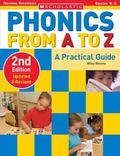Phonics from A to Z: A Practical Guide, a comprehensive guide for teaching reading, is written for classroom teachers who deal with all sorts of reading skill levels as well as disabilities. Simple assessments toward the back of the book help you determine trouble spots and the approximate grade of a student.
While it stresses the value of teaching phonics, Phonics from A to Z also presents other methods of teaching reading, explaining how and when they are best used. Although this is a book about teaching phonics, it might also be the source of your own phonics instruction. It presents an outline for phonics and reading instruction that begins with alphabet recognition and continues through what children should have learned by the end of third grade. However, it is not laid out in fully developed lesson plans for you to pick up and use without preparation.
Many multi-sensory learning activities are provided for various stages of learning. They were written with classroom situations in mind, but many of the activities can easily adapt for working with one child.
I think Phonics from A to Z is likely to be most useful for parents whose children struggle with learning to read, because it does a fantastic job of explaining how reading skills are developed, what strategies to use at each developmental step based on what the research indicates is most effective, and ways to meet the individual needs of children. It spends an entire chapter on articulation. It even addresses teaching children for whom English is their second language.
The book includes a section on phonics rules with a discussion as to which are the most important for children to learn. Forty-five rules are presented along with a “utility rating.” A few rules have 100% utility and the rest range all of the way down to no utility at all based on research. This helps us focus on teaching rules that are actually useful rather than wasting time on those that are only marginally helpful if at all.
While it covers everything through advanced reading skills such as homophones, prefixes, suffixes, compound words, and breaking words into syllables, I think the coverage of pre-reading and beginning reading skills is especially valuable because it is covered more thoroughly than I find in most resources for early learners.
Many reading programs start at a point that assumes that children already know the letters of the alphabet and can begin to connect letters with their most common sounds. Phonics from A to Z reaches this point at chapter four. At the beginning of this chapter, author Wiley Blevins explains, “In this chapter I focus on the ways phonics can be taught, provide recommendations for phonics instruction, and give you sample lessons and word lists to help you plan your phonics instruction” (p. 111). He goes on to present his own explanation of the elements of a good phonics program, many of which are found in programs popular among homeschoolers such as Phonics Pathways and Horizon Phonics. However, he also recommends linking phonics to spelling through dictation and other writing activities, phonemic awareness activities (explained on pages 35-51), as well as hands on activities such as word-building with letter cards.
Word lists are included for practice throughout the book. However, none of them (or other teaching material) is formatted in a way that can be presented directly to students. The typeface in the book is relatively small. So you will need to recreate any potential lesson material in another format. The assessments and articulation charts are the only exceptions. These are in a larger font and may be reproduced for your use. Because of this, I think homeschoolers are likely to use this book as a reference resource rather than the source from which they do their actual teaching. Homeschoolers can incorporate some of the teaching strategies and activities alongside another phonics program if they so choose. (This is how it is used with the Simply Classical program from Memoria Press.)
In summary, Phonics from A to Z offers the “behind the scenes” information for those who need to learn more about teaching phonics, but it also provides very practical suggestions for teaching effectively, especially teaching children with special needs.










